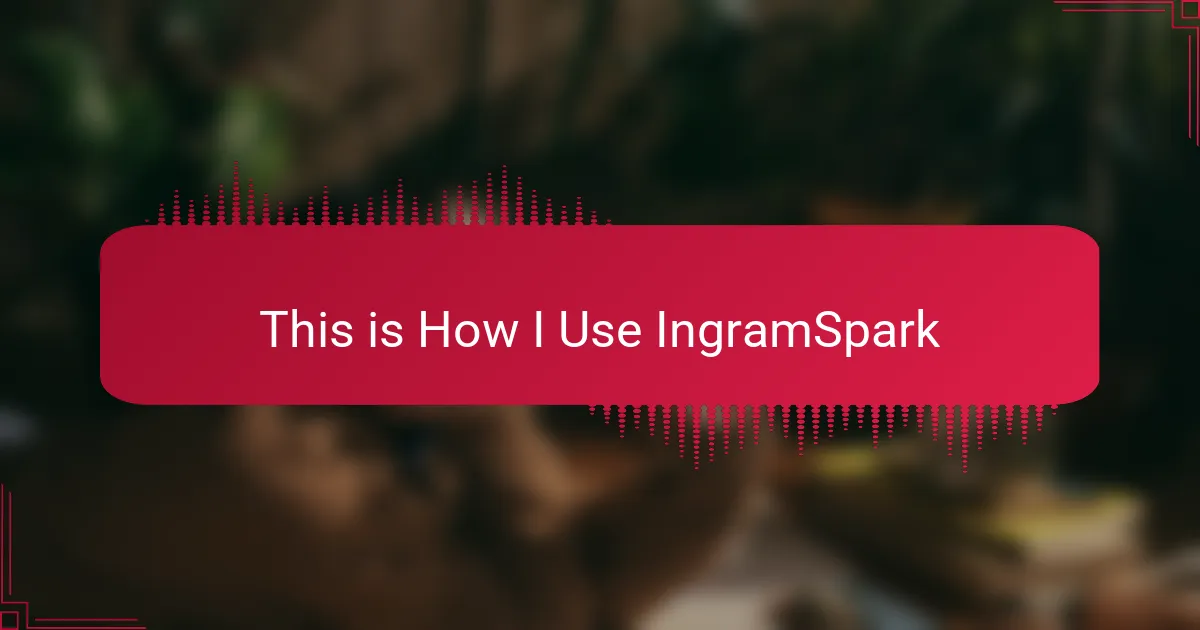Key takeaways
- IngramSpark provides independent authors with a user-friendly platform for print-on-demand publishing and extensive distribution options, connecting works to retailers and libraries worldwide.
- The platform’s flexibility in pricing and distribution allows authors to adjust their strategies based on market conditions and audience engagement.
- Formatting guidelines are crucial for creating a polished comic book, focusing on trim size, bleed, fonts, resolution, file format, and margins.
- Building a marketing strategy, embracing feedback, and networking with other authors enhances the publishing experience and aids in personal growth as a creator.

Overview of IngramSpark
IngramSpark is a leading platform for independent authors and publishers looking to get their books into a wide array of distribution channels. I remember when I first learned about it; I was amazed at how it could connect my comic book to both online retailers and brick-and-mortar stores. The ability to choose print-on-demand services is a game-changer, as it means I don’t have to worry about upfront printing costs.
What really stands out to me is the user-friendly interface. I’ll never forget the moment I uploaded my first manuscript—it felt like a rite of passage. You can easily navigate through the steps for both print and eBook formats. Plus, the guidelines are straightforward, making it easier to create a polished product.
IngramSpark also offers powerful promotional options for authors. I often find myself wondering how other indie creators successfully market their work. With promotional tools and analytics on hand, it provides invaluable insights into where my readers are coming from. This kind of support makes me feel like I have a partner in my publishing journey.

Benefits of Using IngramSpark
The financial flexibility that IngramSpark offers is truly remarkable. One of my favorite features is the print-on-demand option, which means I can produce copies only when I need them. This approach not only saves resources but also allows me to test the waters with my comic book before committing to large print runs that might not sell.
Another significant benefit is IngramSpark’s extensive distribution network. I still remember the thrill when my comic was listed alongside established titles in bookstores and libraries. It was a surreal moment for me, realizing that my work could reach readers far beyond my local scene. Can you imagine the excitement of having your comic on the shelves of a store you grew up visiting?
Additionally, the support from IngramSpark’s community is unparalleled. When I faced questions during my first submission, their responsive customer service was a lifesaver. It felt great knowing I wasn’t navigating this journey alone. Having access to resources and a network of fellow authors makes the process feel collaborative, which I find incredibly encouraging.

Setting Up Your IngramSpark Account
Setting up your IngramSpark account is a pretty straightforward process, but I can tell you from experience, having the right mindset helps a lot. When I first created my account, I remember feeling a mix of excitement and nervousness—as if I was about to embark on a new adventure. The first step is simply providing your email and creating a password. It’s that easy!
What caught me off guard was how quickly I could fill out the essential details like your author information and book metadata. Once you upload your title, a sense of accomplishment washes over you, and you can start visualizing your comic in readers’ hands. I was surprised at how user-friendly it felt, like every element was designed to guide you through the maze of publishing.
As you continue to set up your account, I recommend paying close attention to the payment and tax information sections. I had a few moments of confusion there, but once I sorted it out, I realized how crucial it is for receiving royalties. Have you thought about how much you should save for taxes? It’s a question worth considering, and IngramSpark makes sure you have everything in place to keep your finances on track.

Formatting Your Comic Book
When formatting your comic book for IngramSpark, I often find that the devil is in the details. The process can feel daunting, but I’ve learned that adhering to specific guidelines saves a lot of headaches down the line. I remember my first attempt—it was a mix of excitement and anxiety as I tried to conform to their requirements. Making sure your artwork and text align properly can really set the right tone for your story.
To help you through the formatting maze, here are some essential points to keep in mind:
- Trim Size: Choose the right trim size that suits your comic’s genre and target audience. Standard sizes like 6” x 9” or 7” x 10” are commonly used.
- Bleed: Ensure you include bleed areas in your artwork to prevent any white edges after trimming.
- Fonts: Use legible fonts for dialogue and captions. I’ve found that a clean sans-serif font works wonders for readability.
- Resolution: Keep your images at a minimum of 300 DPI for crisp printing.
- File Format: Save your files as PDF/X-1a or PDF/X-3; this is crucial for preserving quality during the print process.
- Margins: Don’t forget to set appropriate margins, especially for the spine area, to ensure nothing important gets cut off.
Staying organized and following these guidelines has made my journey as a comic book author much smoother.

Pricing and Distribution Choices
When it comes to pricing, I’ve found that IngramSpark offers a flexible range that allows me to set competitive prices for my comic books. This flexibility is crucial; after all, I want my work to be accessible while still reflecting its value. During my first launch, I struggled to find the perfect price point, but with IngramSpark’s guidance and my own testing, I discovered that a little experimentation goes a long way.
As for distribution, IngramSpark delivers an extensive reach that’s hard to beat. I remember feeling a mix of excitement and nervousness when I realized my comic would be available in libraries and bookstores worldwide. This distribution network not only boosts visibility but also adds a professional edge to my work.
- Transparent pricing model that allows authors to set their book prices.
- Global distribution network, reaching bookstores, libraries, and online retailers.
- Print-on-demand options which help reduce upfront costs and inventory issues.
- Ability to adjust pricing and distribution choices easily as market conditions change.

Tips for Successful Publishing
While navigating the publishing landscape with IngramSpark, I’ve found that creating a well-researched marketing strategy is essential. The first time I launched a comic, I was overwhelmed by the options but learned quickly that targeting specific audiences creates more impact. I asked myself, “Who will resonate with my story?” By honing in on my niche and reaching out through social media and newsletters, I felt a genuine connection with my readers.
Another tip I swear by is embracing feedback. After my initial publication, I encouraged my readers to review and share their thoughts. Surprisingly, the insights I received were not only constructive but also inspiring. It made me realize that looking for growth through criticism can elevate your work significantly. There’s a unique joy in turning reader suggestions into improvements for future editions. Have you ever considered how much you might learn from your audience?
Lastly, don’t underestimate the power of networking. When I first connected with fellow authors and industry professionals, I was amazed at the wealth of knowledge shared. Each conversation opened new doors and introduced ideas I hadn’t even considered. Attending events or participating in forums can be a game-changer, and I’ve forged friendships that have not only supported my journey but have also enriched the creative process. Connecting with others creates a sense of belonging in the vast world of comic book publishing.
